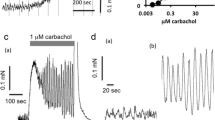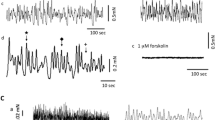Abstract
Since symptoms of bladder dysfunction occur more frequently in women than in men and since muscarinic receptors are the physiologically most important system to mediate bladder contraction, we have compared the number, subtype distribution and function of muscarinic receptors in bladders from male and female rats. Muscarinic receptor function was also assessed in bladder strips from male and female human bladder. Male and female rats expressed a similar number of muscarinic receptors (144±5 vs. 140±6 fmol/mg protein in saturation radioligand binding). While competition binding curves for the moderately M2-selective methoctramine were not consistently better fitted by a two-site model, most competition curves for the M3-selective darifenacin were biphasic and yielded 29±10% and 31±7% high affinity sites (corresponding to M3 receptors) in male and females, respectively. Immunoreactivity of α-subunits of the G-proteins Gq/11, Gi1/2, Gi3 and Gs did not significantly differ between both genders. The muscarinic receptor agonist carbachol similarly stimulated inositol phosphate accumulation in bladder slices from male and female rats with calculated maximum responses of 69±17 and 77±18% over basal and pEC50 values of 4.90±0.45 and 4.40±0.46, respectively. While darifenacin inhibited carbachol-stimulated inositol phosphate formation approximately 100-fold more potently than methoctramine, each antagonist was similarly potent in both genders. Carbachol concentration-dependently contracted bladder strips with a pEC50 of 5.66±0.05 and 5.72±0.06 and maximum effects of 4.3±0.1 and 4.2±0.2 mN/mg wet weight in male and female rats, respectively. The contractile effect of carbachol was concentration-dependently antagonised by the non-selective atropine (1–30 nM), the M1-selective pirenzepine (1–30 M), the M2-selective methoctramine (1–10 µM) and the M3-selective darifenacin (10–100 nM), with the latter exhibiting a partly unsurmountable antagonism. The overall potency of all four antagonists suggested that contraction was mediated predominantly if not exclusively by M3 receptors with no appreciable differences between both male and female rats. Similarly, the maximum effects (4.4±0.6 vs. 4.4±2.4 mN/mg) and pEC50 (6.07±0.05 vs. 6.32±0.14) of carbachol did not differ between genders in bladder samples from 25 consecutive patients. We conclude that number und function of muscarinic receptors and the relative roles of their M2 and M3 subtypes do not differ between urinary bladders of male and female rats; at least with regard to overall muscarinic responsiveness this situation appears to be similar in humans.






Similar content being viewed by others
References
An JY, Yun HS, Lee YP, Yang SJ, Shim JO, Jeong JH, Shin CY, Kim JH, Kim DS, Sohn UD (2002) The intracellular pathway of the acetylcholine-induced contraction in cat detrusor muscle cells. Br J Pharmacol 137:1001–1010
Andersson K-E (1993) Pharmacology of lower urinary tract smooth muscles and penile erectile tissues. Pharmacol Rev 45:253–308
Arunlakshana O, Schild HO (1959) Some quantitative uses of drug antagonists. Br J Pharmacol 14:48–58
Braverman AS, Legos JJ, Young W, Luthin G, Ruggieri MR (1999) M2 receptors in genito-urinary smooth muscle pathology. Life Sci 64:429–436
Braverman AS, Karlovsky M, Pontari MA, Ruggieri MR (2002) Aging and hypertrophy change the muscarinic receptor subtype mediating bladder contraction from M3 towards M2. J Urol Suppl 167 (abstract 170)
Caulfield MP, Birdsall NJM (1998) International Union of Pharmacology. XVII. Classification of muscarinic acetylcholine receptors. Pharmacol Rev 50:279–290
Chess-Williams R, Chapple CR, Yamanishi T, Yasuda K, Sellers DJ (2001) The minor population of M3-receptors mediate contraction of human detrusor muscle in vitro. J Auton Pharmacol 21:243–248
Choppin A (2002) Muscarinic receptors in isolated urinary bladder smooth muscle from different mouse strains. Br J Pharmacol 137:522–528
Choppin A, Eglen RM (2001a) Pharmacological characterization of muscarinic receptors in dog isolated ciliary and urinary bladder smooth muscle. Br J Pharmacol 132:835–842
Choppin A, Eglen RM (2001b) Pharmacological characterization of muscarinic receptors in mouse isolated urinary bladder smooth muscle. Br J Pharmacol 133:1035–1040
Choppin A, Eglen RM, Hegde SS (1998) Pharmacological characterization of muscarinic receptors in rabbit isolated iris sphincter muscle and urinary bladder smooth muscle. Br J Pharmacol 124:883–888
Eglen RM, Choppin A, Watson N (2001) Therapeutic opportunities from muscarinic receptor research. Trends Pharmacol Sci 22:409–414
Fetscher C, Fleichman M, Schmidt M, Krege S, Michel MC (2002) M3 muscarinic receptors mediate contraction of human urinary bladder. Br J Pharmacol 136:641–643
Goepel M, Gronewald A, Krege S, Michel MC (1998) Muscarinic receptor subtypes in porcine detrusor: comparison with humans and regulation by bladder augmentation. Urol Res 26:149–154
Goepel M, Hoffmann J, Piro M, Rübben H, Michel MC (2002) Prevalence and physician awareness of symptoms of urinary bladder dysfunction. Eur Urol 41:234–239
Hegde SS, Eglen RM (1999) Muscarinic receptor subtypes modulating smooth muscle contractility in the urinary bladder. Life Sci 64:419–428
Hegde SS, Choppin A, Bonhaus D, Briaud S, Loeb M, Moy TM, Loury D, Eglen RM (1997) Functional role of M2 and M3 muscarinic receptors in the urinary bladder of rats in vitro and in vivo. Br J Pharmacol 120:1409–1417
Hunskaar S, Arnold EP, Burgio K, Diokno AC, Herzog AR, Mallett VT (1999) Epidemiology and natural history of urinary incontinence (UI). In: Abrams P, Khoury S, Wein A (eds) Incontinence. Plymbridge, Plymouth, pp 197–226
Kiefel JM, Bodnar RJ (1992) Roles of gender and gonadectomy in pilocarpine and clonidine analgesia in rats. Pharmacol Biochem Behav 41:153–158
Longhurst PA, Levendusky M (2000) Influence of gender and the oestrous cycle on in vitro contractile responses of the rat urinary bladder to cholinergic stimulation. Br J Pharmacol 131:177–184
Longhurst PA, Leggett RE, Briscoe JAK (1995) Characterization of the functional muscarinic receptors in the rat urinary bladder. Br J Pharmacol 116:2279–2285
Matsui M, Motomura D, Karasawa H, Fujikawa T, Jiang J, Komiya Y, Takahashi S, Taketo MM (2000) Multiple functional defects in peripheral autonomic organs in mice lacking muscarinic acetylcholine receptor gene for the M3 subtype. Proc Natl Acad Sci USA 97:9579–9584
Michal P, Lysikova M, Tucek S (2001) Dual effects of muscarinic M2 acetylcholine receptors on the synthesis of cyclic AMP in CHO cells: dependence on time, receptor density and receptor agonists. Br J Pharmacol 132:1217–1228
Michel MC, Brass LF, Williams A, Bokoch GM, LaMorte VJ, Motulsky HJ (1989) α2-adrenergic receptor stimulation mobilizes intracellular Ca2+ in human erythroleukemia cells. J Biol Chem 264:4986–4991
Michel MC, Siepmann F, Büscher R, Philipp T, Brodde O-E (1993) Ontogenesis of sympathetic responsiveness in spontaneously hypertensive rats I. Renal α1-, α2- and β-adrenergic receptors and their signaling. Hypertension 22:169–177
Michel MC, Schneider T, Krege S, Goepel M (2002) Do gender or age affect the efficacy and safety of tolterodine? J Urol 168:1027–1031
Michel-Reher M, Gross G, Jasper JR, Bernstein D, Olbricht T, Brodde O-E, Michel MC (1993) Tissue- and subunit-specific regulation of G-protein expression by hypo- and hyperthyroidism. Biochem Pharmacol 45:1417–1423
Milsom I, Abrams P, Cardozo L, Roberts RG, Thüroff JW, Wein AJ (2001) How widespread are the symptoms of an overactive bladder and how are they managed? A population-based prevalence study. BJU Int 87:760–766
Sandmann J, Peralta EG, Wurtman RJ (1991) Coupling of transfected muscarinic acetylcholine receptor subtypes to phospholipase D. J Biol Chem 266:6031–6034
Schmidbauer J, Temml C, Schatzl G, Haidinger G, Madersbacher S (2001) Risk factors for urinary incontinence in both sexes. Eur Urol 39:565–570
Schmidt M, Bienek C, van Koppen CJ, Michel MC, Jakobs KH (1995) Differential calcium signalling by M2 and M3 muscarinic acetylcholine receptors in a single cell type. Naunyn-Schmiedebergs Arch Pharmacol 352:469–476
Tong Y-C, Hung Y-C, Lin S-N, Cheng J-T (1997) Pharmacological characterization of the muscarinic receptor subtypes responsible for the contractile response in the rat urinary bladder. J Auton Pharmacol 17:21–25
Wang P, Luthin GR, Ruggieri MR (1995) Muscarinic acetylcholine receptor subtypes mediating urinary bladder contractility and coupling to GTP binding proteins. J Pharmacol Exp Ther 273:959–966
Wyndaele JJ (2001) The overactive bladder. BJU Int 88:135–140
Yamanishi T, Chapple CR, Yasuda K, Chess-Williams R (2000) The role of M2-muscarinic receptors in mediating contraction of the pig urinary bladder in vitro. Br J Pharmacol 131:1482–1488
Yoshimura Y, Schmidt F, Constantinou CE (2000) Gender specificity of tolterodine on micturition and the diurnal variation of urine production of the conscious rat. BJU Int 87:879–885
Acknowledgements
This work was supported in part by a grant from the Deutsche Forschungsgemeinschaft (Mi 294/7–1). Christian Kories, Tim Schneider and Claudia Wecking were recipients of stipends by the intramural grant programme of the University of Essen Medical School (IFORES).
Author information
Authors and Affiliations
Corresponding author
Rights and permissions
About this article
Cite this article
Kories, C., Czyborra, C., Fetscher, C. et al. Gender comparison of muscarinic receptor expression and function in rat and human urinary bladder: differential regulation of M2 and M3 receptors?. Naunyn-Schmiedeberg's Arch Pharmacol 367, 524–531 (2003). https://doi.org/10.1007/s00210-003-0713-8
Received:
Accepted:
Published:
Issue Date:
DOI: https://doi.org/10.1007/s00210-003-0713-8




